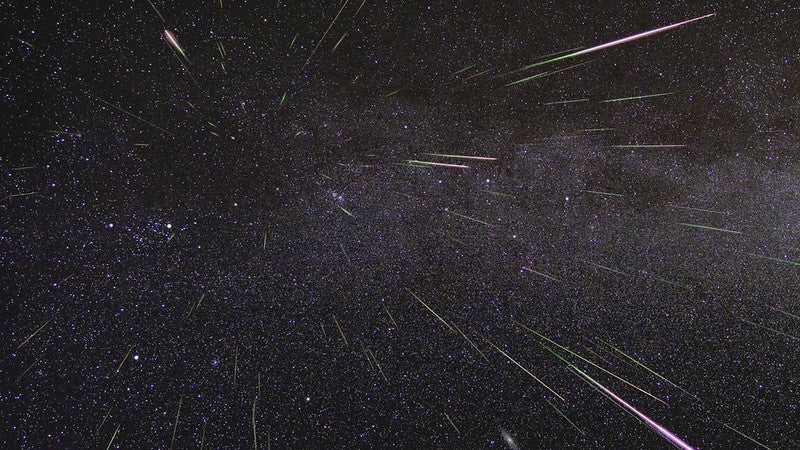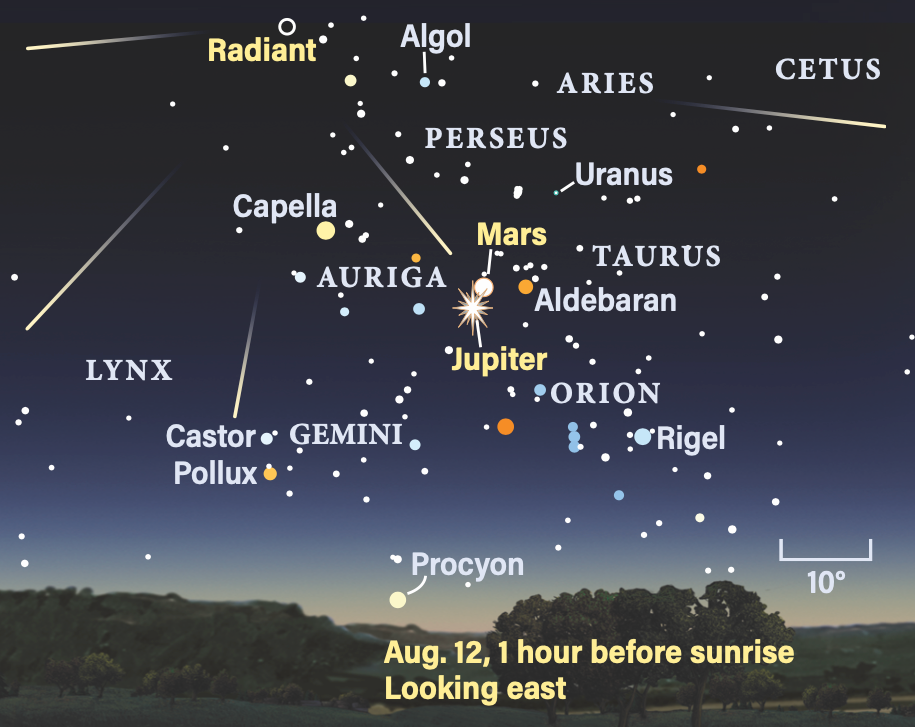
With high rates of meteors and balmy summer temperatures, the Perseid meteor shower is one of the most celebrated of the year. Second in peak rate only to the December Geminids, the Perseid meteor shower this year takes center stage, thanks to the timing of the phases of the Moon.
This year, the Perseid meteor shower peaks Aug. 12 with a First Quarter Moon, which sets before midnight to leave the early-morning hours — the best for enjoying the show — dark and moonless. By contrast, the Geminids’ peak on Dec. 14 this year coincides with a nearly Full Moon, which casts its bright, meteor-hiding light from roughly dusk until dawn.
That means the Perseids are shaping up to become the best meteor shower of the year, not to be missed. Here’s how to watch the show.
When to see the Perseids
You don’t need any equipment to watch a meteor shower — in fact, your eyes are best, as you can scan a large region of the sky quickly without sacrificing field of view for magnification. At most, you might want a lounge chair or blanket, as well as something to keep hydrated and perhaps some insect repellant, depending on your location.
The official peak of the Perseids occurs Aug. 12 in the morning hours for observers in the U.S. This coincides with the best time in general to catch a meteor shower, as in the morning, Earth is rotating into the stream of debris that causes the shower, resulting in longer meteor trains that streak across the sky. However, the morning before and the morning after the peak (the 11th and 13th) will also feature high rates of Perseid meteors, so you can either stretch out your observing over several days or plan for backups if the specific peak date is cloudy or inconvenient.
How to see the Perseids
Perseid meteors appear to come from a specific point, or radiant, in the constellation Perseus, which reaches roughly 60° above the horizon an hour before sunrise this week. The higher the radiant, the more meteors you will see — meteor showers are characterized by their peak zenithal hourly rate, which estimates the number of meteors visible if the radiant were directly overhead (90°). Given how high the Perseids’ radiant will reach before dawn, the shower’s peak rate of some 100 meteors per hour should be attenuated only 15 percent or so, meaning it will still produce more than 80 meteors per hour. That’s more than one meteor per minute!
(Keep in mind, though, that’s an average — you’re more likely to see a lot of meteors in a small amount of time, followed by a short lull, than exactly the same number of meteors each minute out of an hour.)

To find Perseus, look east in the hour or two before sunrise. You’ll see Gemini and Orion just rising, with the V-shaped constellation Taurus above the curved pattern of stars delineating Orion’s bow. Taurus is currently host to three planets, including bright Mars and Jupiter, which are just days away from a close conjunction on the 14th. They lie to the left of the bright orange-red star Aldebaran, which serves as Taurus’ eye. (Check out our Sky This Week column for more details on how to observe this conjunction, and keep your eye on our site for additional information as the event draws nearer.)
Above Taurus in the sky is Perseus, with the Perseids’ radiant in the northern region of the constellation. The radiant is roughly 23° straight above the bright star Capella in the constellation Auriga, to Perseus’ lower left.
Once you’ve found the general area of the radiant, make sure to scan some 40° to 60° away from this point. Because Perseids appear to streak away from the radiant, you’ll see the longest, most impressive trails through the sky some ways away from this point. Perseids in particular are known for trains that are bright and long-lasting. Like all meteors, these streaks are caused by tiny specks of rock and dust burning up in our atmosphere. Don’t worry, though — the pieces of debris that generate meteor showers are so small that they burn up completely before ever hitting the ground.
The Perseids are generated by debris left over from past visits of Comet 109P/Swift-Tuttle, which returns to circle the Sun every 133 years. Its most recent perihelion (close pass of the Sun) was in 1992, and it won’t grace our skies again until 2125. However, Swift-Tuttle is a large comet some 16 miles (26 kilometers) across, which means it’s got plenty of material to fling off each time it heats up near the Sun. That material, which remains roughly along the orbit of the comet, intersects Earth’s orbit in August and creates the Perseid meteors we see.
Below are the times of sunset and sunrise, as well as moonset and moonrise, on the Perseids’ peak and one day on either side of that peak. Overall, the Perseids are active from late July through late August, so you may continue to see stragglers for the next two weeks or so — but the real show will be Aug. 11–13, so make sure you don’t miss it!
Sunday, August 11
Sunrise: 6:08 A.M.
Sunset: 8:01 P.M.
Moonrise: 1:04 P.M.
Moonset: 11:12 P.M.
Moon Phase: Waxing crescent (41%)
*Times for sunrise, sunset, moonrise, and moonset are given in local time from 40° N 90° W. The Moon’s illumination is given at 12 P.M. local time from the same location.
Monday, August 12 — Perseids peak
Sunrise: 6:09 A.M.
Sunset: 8:00 P.M.
Moonrise: 2:08 P.M.
Moonset: 11:42 P.M.
Moon Phase: Waxing gibbous (51%)
Tuesday, August 13
Sunrise: 6:10 A.M.
Sunset: 7:59 P.M.
Moonrise: 3:14 P.M.
Moonset: —
Moon Phase: Waxing gibbous (61%)

